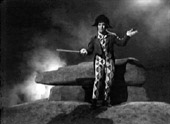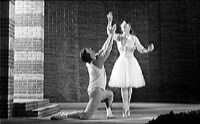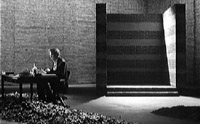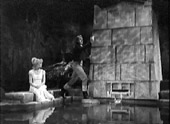Happenings and performances came about as a revolt against the illusionist
character of the scenic art form. In a happening the space is not a stage and
the participants are not actors cast for a part. Instead, happenings and
performances have their roots in the anonymous and systemic aesthetics of the
art of painting of the 1960's, but one cannot disregard that Kirkeby's
happenings and installations of the 60's and 70's did not quite keep within
these limits. His happening, Arctic (1967-68), where he sat in front of
a tent with mounds of gravel, ice and rocks around him, was actually about
himself on expedition on Greenland, and at the sculpture festival arranged by
the periodical ta' in Galerie 101 in Copenhagen in 1967, he created a
space filled with branches and leaves which also was theatrical because it gave
the illusion of being in a forest.
Kirkeby also made the costumes for the play. The men's costumes were real fencing outfits and the women's consisted of long red/white/blue/black ribbons. These ribbons were meant to reveal the objects of desire, a breast or a leg, when the women moved about, but the very Århusian drama students who performed the play chose to wear their underwear underneath the loose ribbons. In 1968, Jørgen Leth also made a screen version of Ophelia's madness scene, titled Ofelias blomster (Ophelia's Flowers), where he once again made use of systemic interruptions in order to transform and break up the story and the text. In this case, his drumbeats not only guided Ophelia's monologue - played by Lene Adler Petersen - but also the focus of the optics in the two cameras. It was Per Kirkeby who had found the location, a moor in northern Zealand where peat had once been cut, and the actors were able to play on the square terraces all the way down to the seashore. Here, Kirkeby had erected a screen made of three panels of blue canvas, which formed a space or a stage for Ophelia, dressed in the same costume as was used at Svalegangen in 1965. Incidentally, Niels Schwalbe produced two other short films about Leth's production of Ofelias blomster at the same time.
The collaboration of Leth and Kirkeby continued in 1970 with the short film
Dyrehaven, den romantiske skov (The Deer Park, the Romantic Forest). The
skeleton of the film simply consists of the four changing seasons, and the
individual scenes or shots therefore appear as separate images. The very
beautiful and almost kitschy pictures are, to a large extent, a type of quote
from art-historical sources, such as Pieter Brueghel's The Hunters in the
Snow and Danish Golden Age painting.
The contradiction is primarily concretized in a story about a married couple who have placed their daughter, Maria, with foster-parents for the purpose of making her forget her infatuation with a young man "above her station". In order to cheer the girl up, they bring her along to Dyrehavsbakken and The Deer Park on a midsummer's day, and the plot and mix-up comedy then takes shape as her beloved, Ludvig, happens to turn up and present himself to the foster parents as "a young gentleman from Langeland", which permits him to walk arm in arm with Maria all day long in front of the unsuspecting foster parents. Even when their love conquers all in the end, the victory does not come about as a result of conflict and struggle, but solely because the genius of love is merciful. The contrast between the two prologues also takes shape as the bourgeois meet the mountebanks, an image of "the beautiful but useless poetry", but the conflict never becomes any fiercer than a threat from some of the bourgeois to beat up the tightrope walker. The play begins with the prologues at the old tumulus, followed by a scene from a bourgeois home in the city and the bourgeois' trips in horse-drawn carriages to Dyrehavsbakken, where the mountebanks are introduced one by one standing in front of their stalls and tents: the tightrope walker, the Jewish boy, the mirror room, inside which the world is seen upside down, and the puppet show in the house of comedy. Here, Oehlenschläger satirized the bourgeois' enthusiasm for a moralizing play about a young man who marries for money but who, in the end, is given his - in the bourgeois' view - well-deserved punishment. The scene in which Maria and Ludvig sit by the monument at Kirsten Pil's Spring for the first time appears in the middle of the play. Then, one sees the old Jew singing an indecent song in Low German, followed by the eager gathering of the bourgeois and the arbiters of taste in front of the cabaret tent where a "parrot" recites a homage to mediocrity. Night is falling and in the forest, now red in the twilight, one sees three nymphs dressed in white. Maria passes her wallet to a blind beggar who has lost his violin, the violin that interpreted his misery, just before the family is seated on the benches and empty their picnic baskets. In the end, one sees Maria and Ludvig once again in front of Kirsten Pil's Spring while the elders search for Maria, and the genius of love takes pity on the young couple. The epilogue is presented by a hunter who picks up where the wanderer left off praising nature and the past. The hunter declares that he is not in love with a girl but he feels the even more powerful love that permeates all nature.
Oehlenschläger's drama, Sanct Hansaften Spil, and Dyrehaven, den
romantiske skov are quite similar because both works are held together by a
thin plot or a simple skeleton and they can be broken down into single images.
Perhaps this is the reason why Jørgen Leth and Per Kirkeby, as director
and scenic artist/costumier respectively, became responsible for the Danish
television production of Oehlenschläger's play that was shown on the 16th
of December, 1979. Their version is very close to Oehlenschläger's
original.
The idea behind Sankt Hansaften Spil was that the play was to be recorded in a single television studio. Kirkeby covered the floor with peat litter - where footprints were visible, and where light was reflected in a peculiar, woolly manner, also recalling the room with leaves and branches from 1967 or the film shots in the peat bog in 1968 - and he covered three of the walls with a large canvas painted to resemble a Danish beech forest. On the fourth wall there was, of course, a window to the control room, as there is in a television studio. This installation art approach was supplemented by a series of solutions that obviously originated in the aesthetics of Kirkeby's paintings from the 1960's. The back curtain was, for instance, constant, whereas the lighting changed and created a progression of colour throughout the play, made up of simple, cartoon-like codes. When morning breaks, the tumulus is shrouded in a grey fog that eventually turns red as the sun rises. As the bourgeois ride in horse-drawn carriages from the city the fog is still grey, but a shimmer of green flecks breaks through. At Dyrehavsbakken, the background, glimpsed behind stalls and tents, is green at first with brown tree trunks. At dusk, it becomes red again, and late in the evening the background is blue-violet with black silhouettes of trunks and branches. Irony is another effect that Kirkeby transferred from his painting to this scenic assignment. The 1970's was a decade dominated by the wish for realism with a political emphasis, and only by means of irony were Leth and Kirkeby able to transmit an image of a tumulus on public television. All in all, it is the aim of Kirkeby's art, as well as of this television theatre production, to create beautiful and emotional images. Like his models, the German romanticist painters Carus and Friedrich, Kirkeby moves the set pieces around and places them where they achieve the greatest effect. This is why the gnarled, old oak tree could stand both between the stalls at Dyrehavsbakken and a bit later next to Kirsten Pil's Spring, deep inside the deer park. This is also why the bourgeois living room was built directly underneath the tumulus, so that the photographer only had to tilt the camera from the first to the second scene, which naturally emphasized the theatrical, understood as the artificial and contrived. Several of the images were so beautiful - the orange-red sunset and the creeping theatre fog - that they came close to being consciously kitschy. American painting of the 1950's and Danish painting of the 1960's ended up in horizontal lines, and this was believed to have liberated painting from depicting a motif. The art of Kirkeby polemically rejected this American avant-garde mode of thinking by claiming that pure painting, liberated from motif, does not exist. The stalls at Dyrehavsbakken in Sanct Hansaften Spil, made of wooden boards and striped canvas were one of Kirkeby's examples of how these two-coloured stripes are pure, while at the same time unquestionably also meaning and depicting something quite definite. The bourgeois living room was undoubtedly taken directly from an interior in a Danish Golden Age painting. Several of the costumes were in glaring, manneristic colours, but Kirkeby insisted that the gentlemen's coats not just look like but also be tailored as in the Biedemeier period with narrow back pieces that made the actors arch their backs and strut around like roosters. This posture also filled their lungs with air, better enabling them to recite Oehlenschläger's verses with the correct diction. In the 1970's, television productions were normally bathed in light, but in Sanct Hansaften Spil the light is subdued -
like the atmosphere in the bourgeois home when the morning light falls through the curtains or when the light filters through branches and leaves creating a glimmering flicker on the forest floor. The light source was furthermore placed very low, and this is why the actors cast long shadows. It is interesting to note that the shadow first became a main motif in Kirkeby's art after 1979, but otherwise, one can rightly claim that several of the motifs from Kirkeby's earlier paintings, happenings and installations are not only found in Sanct Hansaften Spil, but were realized so successfully here that these details must have been inherently theatrical right from the beginning. The possibly final off-spring of the collaboration between Leth and Kirkeby came in 1989 with Notater om kærligheden (Notes on Love), which is a 90-minute, 35 mm film with script and direction by Jørgen Leth and studio scenery by Per Kirkeby. Bronislaw Malinowski's book, The sexual Life of Savages in North-Western Melanesia (1929), was one of the sources of inspiration for the film. Malinowski was the founder of the theory of functionalism in anthropology and ethnography, and his stay on the Trobriand Islands and in northwest Melanesia from 1914 to 1918 revolutionized field work. Quite like when Per Kirkeby, Ib Michael and Teit Jørgensen set out in 1971 for Mayaland in the footsteps of John Stevens and Frederick Catherwood, Leth says in Notater om kærligheden that he went to Papua New Guinea in Malinowski's tracks in order to describe love. In doing this, of course, he also picked up the thread from the drama about Hamlet and Ophelia and from Oehlenschläger's romanticist play about love. Although Notater om kærligheden is a feature film, it possesses the unmistakable characteristics of the experimental and short films made by Leth in his youth. Just as Niels Schwalbe produced a film on the making of Ofelias blomster, there are also shots in Notater om kærligheden, which show the making of the film itself. The film also becomes intellectual through the fact that there is no plot, no principal characters but rather a multitude of subordinate parts of equal importance and hardly any dialogue. Furthermore, the film consists of shots from seven or eight different sources, but these sources are fragmented - possibly according to a system, it is difficult to guess - into individual images and then mixed up. Therefore, Notater om kærligheden can be regarded as a continuation of the style from Dyrehaven, den romantiske skov and Sanct Hansaften Spil, in the sense that it has no plot or any other skeleton and dissolves into a series of individual images that follow one after another. The absence of a plot is also found in the images where most of the actors have been filmed frontally. One of the layers in the film consists of Bronislaw Malinowsky's own still photos from the beginning of the century which are shown in two sequences. Another related layer consists of Leth's shots, where he literally followed in the footsteps of Malinowsky to the Trobriand Islands and shot whatever glimpses he got of lovelife on the islands. The result is like a series of artificial situations, where natives are paid and instructed by an interpreter to stand in front of a screen and pose for the camera while they perform simple actions such as fixing their hair, washing, rubbing their bodies with oil or tattooing and painting their faces a bit. Most of the film is in black and white, and there are only two kinds of cuts in four colours. One is of an old tree that is floodlit and photographed at night, seen from slightly changing angles. The other is quite kitschy pictures of the sunset while sailing in a canoe on the river or seen from a window in a hut by the beach. Both repeat elements from Sanct Hansaften Spil, and these two kinds of banal clichés evoke moods that recall feelings of love. The banal is often the best means to express the wordless. There are also shots from Vienna and Paris where one looks up from the street towards buildings that could be hotels with open shutters and balcony doors, where something erotic might be taking place inside in the darkness. Other shots are from Nicaragua where one sees a woman, perhaps Leth's wife, who is silent, smoking a cigarette, driving a car and enjoying the view from a terrace. The last and most interesting source of these shots consists of studio recordings of love's many different expressions. The "scriptwriter" sits in the middle of the room, writing with a scratchy pen in a small notebook, hammering something down onto a piece of paper on a small portable typewriter or listening to a couple of words recorded on an audio cassette. He tries to compose a hit song, which would usually be about love, and twists and turns the words. We also see two ballet dancers performing a pas de deux from August Bournonville's ballet, Sylfiden (fig. 2). Edith Guillaume sings an aria, which also in both words and music interprets feelings that have to do with love. One furthermore sees different couples - some speaking Danish, others Spanish - who exploringly caress each other, and women putting on love's masks by fixing their hair, putting on lipstick and eyeshadow. This is, incidentally, a quite amusing parallel to Jørgen Leth himself who starts the film off by smearing his face with shaving foam and then shaves off the stubbles of his whiskers.
The problem is, of course, how to depict love. What does it look like? It
hides all the time, indefinably behind smoking cigarettes, words and
masks. It might be a bit confusing that there is constant cross-cutting between
various sources - from Papua New Guinea to the studio in Copenhagen to Paris to
Nicaragua, etc. - but it also creates the paradoxical overview, being able to
see that love's masks and actions are the same practically all over the world.
A film studio can be more consistent in a purely spatial sense because it can be closed on all four sides, whereas a television studio has the window on one of the walls out to the control room. It is, first and foremost, Per Kirkeby's scenery for the studio recordings that makes Notater om kærligheden an interesting and significant film. Kirkeby covered all four walls in the large studio with the kind of straw matting that is sometimes used as windbreaker near terraces. Since the film is semi-pornographic - once again with splinters of desire showing through - this matting gives a sort of Venetian blind effect and one feels like a voyeur spying on an intimate and private scene. There is the one difference, though, that while the natives on the Trobriand Islands display themselves in front of screens - designed by Naja Salto with two-coloured stripes just like the canvas in Sanct Hansaften Spil - the Europeans in the studio recordings are practically hidden behind the mats. A crescent-shaped pile of dead leaves had been arranged in the middle of the studio. This was, of course, the floor covering of dead leaves or peat litter from Kirkeby's earlier productions that here had been stylized into an abstract form, also functioning as an erotically rustling bed from which a naked woman emerged. The third element was a "room", drawn by Kirkeby and constructed of red and yellow bricks in the film studio. It consisted of
a square platform which was open on one side with a step down to the floor, closed on the other three sides by high walls, and had no roof (fig. 3). It was architecture in its most simple form, like a screen similar to the three-paneled screen in Ofelias blomster.
Since Notater om kærligheden was so simplified, it very clearly
demonstrates Per Kirkeby's method of work: he creates an installation in space
for which he needs an entire room, and then he constructs an architectonic
scenery within it. In this room, a bed and a desk also appeared but there were,
however, no longer several mobile, transportable set pieces. The scenery might
still consist of artificial, impressive set pieces but here they had been made
immovable and heavy.
Kirkeby took the final step toward an architectonic scenery with Notater om kærligheden because the scenery here was made of bricks instead of the wood, canvas, etc., he had used earlier. A scenery made of bricks or concrete blocks weighs much more and is a greater strain on the stage floor. It is difficult to use real building materials in indoor theatre. Therefore, it was probably not by coincidence that what happened in the period between Sanct Hansaften Spil and Notater om kærligheden, and which must have been the decisive factor, was Kirkeby's scenery for an outdoor production in Sicily of Pirandello's Sagra del Signore della Nave (The Feast for the Lord of the Ship) (1985). It was on this occasion that Kirkeby had scenery built of real building blocks for the first time. When using real building materials on stage instead of imitations, a subtle change occurs. Papier-maché bricks look realistic through their reference to reality whereas real bricks do not refer to anything else and therefore seem abstract and artificial. Furthermore, brick scenery possesses the quality of combining the systems and the anonymity of the installations in space of the 1960's with the classical demand for the location's unity, since the scenery cannot be changed or removed in the course of the performance. The closest connection to the art of painting lies perhaps in the picturesque perception of space in Kirkeby's stage sets. In a painting, the moods and emotions of the figures are comprehended through their surrounding space, and the same thing happens in Kirkeby's stage sets. Kirkeby's paintings are made up of ordinary structures that are constructed out of pure necessity and the same is found both in his painted backdrops, for example for the Swan Lake production, and in his stage sets. When building a house certain technical and functional structures must be present, otherwise the house will not function and may even fall apart, and this is why Kirkeby has employed an architectonic scenery. The scenery would become too explicit if emotion were the starting point. When, instead, the scenic space is made of ordinary structures out of pure necessity, the space is empty to begin with but it will gradually fill with emotion as the performance unfolds.
|



